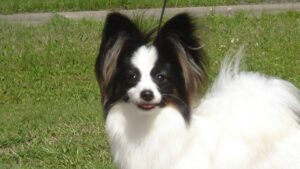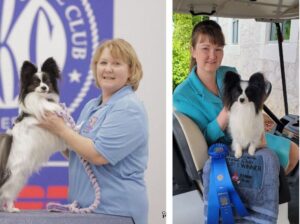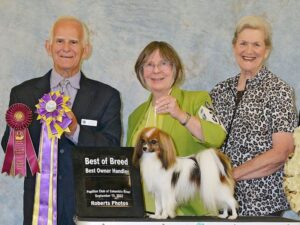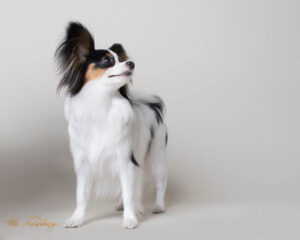
‘Papillon’ – Butterfly in French / Delightful Companion in English
Explore the delightful world of Papillons – their playful nature, intelligence, and unique beauty. See what makes them wonderful companions!

Home » Dog Breeds » Papillon Dog Breed
Once known as the Continental Toy Spaniel, the Papillon (French for “butterfly”) is a small and elegant breed, renowned for its distinctive butterfly-like ears and plumed tail. (A drop-eared variety is commonly referred to as the Phalène (French for “moth”). This breed combines delicate beauty with a robust constitution and vibrant personality. Favored by nobility for centuries, the breed’s expressive, alert demeanor and abundant coat make it a perennial favorite, with an amiable nature that endears it to those who appreciate an active and amiable little dog.
Toy
8 – 11 inches
5 – 10 pounds
14 – 16 years
| Country of Origin | Belgium, France |
|---|---|
| Bred For | Court Dogs, Companionship |
| Known For | Butterfly-Like Ears, Fine Bone, Lively Action |
| Popularity | Moderate |
| Temperament | Alert, Friendly, Happy |
| Activities | Walking, Playing, Conformation Shows, Dog Sports |
The Papillon, whose name translates to “butterfly” in French, owing to the breed’s distinctive, butterfly-like ear fringes, has a history that is as rich and decorative as the dogs themselves. Originating from the toy spaniels that are frequently depicted in paintings by the Old Masters, from Titian to Rubens, the Papillon has graced the laps of ladies and nobles throughout the Renaissance era.
The breed’s development is primarily European, with significant refinement taking place in France and Belgium. This toy spaniel became particularly fashionable in Italy and Spain, where they were bred smaller and given the distinctive erect-eared look that differentiates the Papillon from its drop-eared counterpart, the Phalène, which translates to “moth,” a variety that still exists today.
The Papillon was not only a lapdog. It was a companion to the nobility and royalty across Europe, and has been owned by historical figures such as Madame de Pompadour, Marie Antoinette, and the infamous Marquise de Sévigné.
Official recognition of the breed has been widespread, with the American Kennel Club (AKC) acknowledging the Papillon in the early 20th century, specifically in 1935. The Fédération Cynologique Internationale (FCI) also recognizes the Papillon, as does The Kennel Club (UK), solidifying the breed’s global recognition.
Throughout its history, the Papillon has remained true to its heritage as a charming and intelligent companion dog, thriving in various roles from a royal favorite to a competitive show dog, and as a beloved pet. The breed’s presence in modern times, from dog shows to homes, attests to its timeless appeal and the successful preservation of its lineage and distinctive characteristics.
Adult Papillons usually stand between 8 and 11 inches tall at the shoulder. The weight of a Papillon is typically commensurate with the height, but ideally, an adult Papillon should weigh between 5 to 10 pounds, maintaining a graceful and slight build without appearing frail. Dogs over 11 inches in height are not acceptable.
Proportion and substance are key elements of the Papillon’s profile. The breed should exhibit a balanced appearance with a slightly longer body than tall. Despite their fine-boned structure, these dogs possess a sturdy body that displays a certain quickness. They should not appear too dainty or delicate; rather, they should showcase a balance of agility and ease. The harmony of proportions contributes to the breed’s elegance and its ability to perform as both a fun-loving companion and a successful competitor in many dog sports.
Texture: The coat is one of Papillon’s most distinctive features, with a fine and silky texture that lies flat and flows elegantly when the dog moves. The absence of an undercoat contributes to the coat’s silky feel, and while the coat is abundant and long, it should not hinder the Papillon’s movement or appear overly thick. The hair is short on the skull, muzzle, front of the forelegs, and from the hind feet to the hocks, and it is long on the back of the forelegs as feathering, back of the hindlegs as breeches (culottes), and on the tail as a plume. A profuse frill covers the chest and the ears are well fringed with long, silky hair.
| Standard Color | |
|---|---|
| White & Black | ee |
| White & Lemon | ee |
| White & Red | ee |
| White & Sable | ee |
| White Black & Tan | ee |
| Black Brown & White | n |
| Black Red & White | n |
| Brown & White | n |
| Fawn & White | n |
| Red | n |
| Red White & Sable | n |
| Sable | n |
| White | n |
| White & Liver | n |
| White & Silver | n |
A Note About Color: The Papillon is always parti-colored or white with patches of color(s). On the head, the colored area must cover both ears (front & back), and extend without interruption from the ears over both eyes. A clearly-marked white blaze and noseband are preferred and symmetrical markings are desirable, thus creating the impression of a butterfly. The size, shape, and placement (and the presence or absence) of colored body patches are unimportant, although ears that are colored white, in whole or in part, and eyes that are surrounded by white are not desirable. All-white dogs and dogs with no white are not acceptable in the breed.
| Standard Marking | |
|---|---|
| Black Markings | n |
| Black Mask | n |
| Red Markings | n |
| Sable | n |
| Tan Markings | n |
The tail is a prominent feature of the Papillon, carried proudly arched over the body and covered with a long, flowing plume of hair. It is set high, curving over the back without turning to either side, giving the breed a look of refinement and poise. The tail’s carriage often reflects the dog’s mood and level of alertness, but when relaxed, it may be carried lower. Regardless, the tail is an extension of the spine and thus should not be kinked or deviate from the ideal description.
This Papillon’s plumed tail is an important component of the breed’s silhouette. It is arched over the back, never docked, with long hair that falls elegantly on either side of the body, resembling the fine spray of a well-groomed fountain. In motion, the tail’s feathering may flutter gracefully, accentuating the breed’s lively gait.
The Papillon, with its friendly demeanor and spirited nature, is a popular choice among dog enthusiasts and families. However, owning this breed, as with any dog, comes with specific responsibilities and factors to consider to ensure the well-being of both the dog and the caretaker.
The Papillon generally boasts a robust and resilient constitution that is characteristic of the breed. However, as all breeds and mixed breeds, it may be predisposed to certain hereditary health conditions. It is important for prospective owners to be well-informed about these potential health concerns and to engage in diligent health monitoring and care with the guidance of a reputable breeder and a competent veterinarian.
Papillon breed is known for its longevity, with an average lifespan of 14 to 16 years, but with proper care, regular check-ups, and a balanced diet, many can thrive beyond these years.
The Papillon, while largely a healthy breed, may be prone to certain health conditions. Caretakers should be vigilant and aware of these risks:
Regular health screenings and early detection can help with managing or even preventing some of these conditions. Annual check-ups with a veterinarian, along with a watchful eye for any unusual signs or behaviors, are crucial for the well-being of a Papillon.
The Papillon is an embodiment of grace and vivacity, traits that endear them to enthusiasts and pet owners alike. Their personality is characterized by a sprightly intelligence and a cheerful disposition, making them excellent companions, particularly for those who can match their lively spirit with equal enthusiasm. While they are agile and alert, these dogs also possess a sweet-natured gentleness, a combination that often makes them adaptable to various living situations, including the bustling family environment.
For the novice owner, Papillon’s eagerness to please and quick learning aptitude come as a welcome surprise. However, their sensitivity to the tone of voice and environment should not be underestimated. It is important for training to be consistent and positive, as harsh methods can often do more harm than good with this breed. When it comes to being alone, Papillons generally prefer the company of their human companions and can struggle with isolation. Therefore, they are best suited to households where they can enjoy regular interaction.
Their amiable nature extends to their relationships with other dogs; they tend to be sociable and playful. However, due to their small size, interactions with much larger dogs should be supervised to prevent any accidental harm. Similarly, while Papillons can be wonderful with children, the play should be supervised, especially with younger children who may inadvertently handle them too roughly.
Papillons often greet strangers with enthusiasm, yet they retain a discerning instinct, which can make them excellent alert dogs. Their friendliness does not detract from their ability to be cautious in new situations, making them well-balanced pets who are both welcoming and wise. It’s this blend of traits that make the Papillon an engaging and delightful breed to consider for those seeking an active and affectionate canine partner.
Feeding a Papillon requires attention to their small size and high energy levels. As puppies, they need a diet that supports their rapid growth and development, typically involving more frequent meals of specially formulated food for small-breed puppies. The transition to adult food should be done gradually and under the guidance of a veterinarian to avoid any digestive upset.
For an adult Papillon, the amount of food, usually measured in cups per day, should correspond to their activity level, age, and individual metabolism. While there’s no one-size-fits-all answer for the exact quantity, many adult Papillons thrive on a daily intake ranging from a quarter to a half cup of high-quality dry dog food, divided into two meals.
Monitoring their weight is crucial, as overfeeding can lead to obesity, particularly in a small dog with a dainty structure like the Papillon. Adjusting food portions and treating practices will be important to maintain their ideal weight. To determine the appropriate amount, consult with a veterinarian, who can recommend a feeding schedule and amount based on the specific needs of your dog.
For Papillons, who often exhibit a hearty appetite, it’s essential to measure their food and resist the temptation to offer too many additional treats or table scraps. They might be small, but their nutrition needs to be taken as seriously as that of a larger dog, with a balanced diet being paramount for their overall health and well-being. Regular check-ins with the vet can help confirm that their dietary needs are being met as they grow from playful puppies into elegant adults.
Training a Papillon can be a rewarding endeavor, thanks to their sharp intellect and desire to please their human companions. They typically respond well to positive reinforcement techniques such as praise, play, and treats, which can make training sessions both fun and effective. Their intelligence means they pick up on commands quickly, but it also means they can become bored with repetition, so keeping training varied and engaging is key.
While they are not known for excessive barking, Papillons may alert you to new stimuli in their environment, which can be managed with consistent training. They have moderate tendencies to bark, which can be curbed through proper socialization and training from a young age.
Their smart and curious nature often leads them to explore and sometimes wander, which underscores the importance of reliable recall training. Although they are small, they have a surprising level of energy and enjoy activities that stimulate both their mind and body.
Despite their size, Papillons have a good deal of prey drive, which is a remnant of their history as companions for noblewomen and symbols of alertness and watchfulness in historic paintings. Therefore, they might chase after small animals if given the chance.
Their size does not limit their ability to learn a wide array of tricks and behaviors. From basic obedience to more complex tasks, Papillons are capable and enthusiastic students. Consistent, patient training can tap into their natural abilities, making them stars in obedience and agility courses.
The key to successfully training a Papillon lies in understanding their personality. They respond best to a gentle approach and can be sensitive to harsh tones or treatment. Their training should be an exercise in building a bond of mutual respect and enjoyment, which will lead to the best outcomes for both the dog and their handler.
The Papillon may be diminutive in size, but their exercise needs are not insignificant. These spirited dogs possess an abundance of energy that necessitates regular physical activity to maintain their mental and physical health. Despite their elegance, Papillons exhibit a surprising level of endurance and enjoy engaging in play that stimulates their quick reflexes and satisfies their innate curiosity.
| Energy Level | Moderate to High |
|---|---|
| Exercise Requirements | 30 Minutes/Day (Minimum), Daily Walks, Regular Exercise, Playing with Another Dog, Mental Stimulation |
Daily exercise for a Papillon should include a combination of physical activities like walks or play sessions, along with mental challenges such as puzzle toys or training exercises that tap into their intelligence. They are known for their agility and often excel in dog sports that allow them to demonstrate their nimble movements and sharp minds.
The intensity of the exercise should be moderate, in line with their size and physical capabilities. Vigorous play sessions can be interspersed with periods of rest to ensure they don’t overexert themselves. Playfulness is a hallmark of the breed, and they often enjoy interactive games that involve both their human partners and other dogs.
Engaging a Papillon in regular exercise not only keeps them fit but also helps to mitigate potential behavior issues that can stem from boredom or excess energy. A well-exercised Papillon is typically a happy and content companion, less prone to anxious behaviors or unwanted barking.
While they are adaptable to various living situations, including apartment living, it is crucial to provide them with enough exercise to prevent restlessness. This can be achieved through indoor play if outdoor space is limited. However, access to a secure area where they can run freely and explore is ideal for meeting their exercise requirements.
Incorporating exercise into the daily routine is essential for the Papillon, and when their energy is channeled through positive outlets, their delightful personality shines brightest. The goal is to provide balanced activity that aligns with their vivacious spirit without overtaxing their petite frame.
Grooming a Papillon is a task that combines the need for regular maintenance with the opportunity to bond with your dog. Their long, flowing coat is surprisingly easy to care for, considering its length and fineness. The Papillon does not have an undercoat, which reduces the amount of shedding to a manageable level. Regular brushing, about two to three times a week, helps to keep their coat tangle-free and maintains its silky texture.
| Coat Type | Long, Fine, Silky, Flowing, Straight |
|---|---|
| Grooming Requirements | Weekly Brushing, Occasional Bathing, Routine Ear Cleaning, Periodic Nail Trimming, Regular Tooth Brushing |
When brushing a Papillon, it’s important to be gentle to avoid damaging the fine hairs. Using a soft-bristled brush can effectively remove loose fur and distribute natural oils throughout the coat, keeping it healthy and shiny. Despite their elegant appearance, Papillons are still dogs that love to play and sometimes get dirty, so occasional baths are necessary to keep them clean. However, overbathing can strip their coat of natural oils, so it’s important to bathe them only when needed.
The amount of shedding for a Papillon is generally low compared to other breeds, but they will shed some hair, especially seasonally. Regular grooming not only minimizes the amount of hair left around the home but also allows for early detection of any skin issues or parasites.
In addition to coat care, Papillon grooming also includes dental hygiene, nail trimming, and ear cleaning. Cleaning their teeth regularly can prevent dental issues, which small breeds can be prone to. Their nails should be trimmed regularly to avoid overgrowth, which can be painful and cause problems walking. Ear care is particularly important for Papillons due to their large, open ears; keeping them clean and dry can prevent infections.
Living with a Papillon can be a delightful experience, as they adapt well to a variety of living environments, including apartments. Their small size makes them suitable for compact living spaces, provided their exercise needs are met. Despite their active nature, they can thrive in smaller homes if they are given ample opportunity for play and activity throughout the day.
Papillons are generally good companions for those living in climates with moderate temperatures. They do possess a single coat that provides some insulation, but because they lack a dense undercoat, extreme cold can be challenging for them. In such conditions, protective clothing and limited exposure to the cold can help keep a Papillon comfortable during short walks.
Conversely, in hot weather, Papillons require protection from the heat and adequate shade and hydration, just like any other dog. Their coat can offer some protection against the sun, but it’s important to avoid prolonged outdoor activity during peak sun hours to prevent overheating. Indoor play and exercise during the hottest part of the day can help in maintaining their energy levels while keeping them safe.
When considering living arrangements for a Papillon, it’s also important to think about their social needs. They form strong bonds with their human companions and can be prone to separation anxiety if left alone for extended periods. Therefore, it’s beneficial to have a schedule that allows for regular interaction throughout the day, whether that’s through a family member’s presence or via a pet sitter or doggy daycare.
One of the many joys of living with a Papillon is their adaptable nature. They can be as content lounging on the couch with their caretakers as they are taking brisk walks or engaging in play. Their intelligence and alertness make them excellent housemates, and they tend to be quick to alert their family to anything unusual.
Raising a Papillon puppy is a commitment that comes with the joy of watching a lively and affectionate companion grow. These puppies are as inquisitive as they are spirited, with a dash of mischief in their bright eyes. From the moment a Papillon puppy bounds into your life, it brings an air of elegance and an enduring zest for play.
Caring for Papillon puppies demands attentiveness to their physical and social development. Early socialization is crucial and should include exposure to various people, sights, sounds, and experiences. This early exposure helps your Papillon puppy grow up to be a well-rounded dog, fostering confidence and ease in new situations.
Nutrition tailored to small-breed puppies is vital for their growth and health. These puppies often benefit from a diet formulated for their high energy levels and developmental needs. Proper feeding schedules and portion control are important to avoid overfeeding, as small breeds can easily become overweight with excessive calorie intake.
Regular veterinary check-ups are a cornerstone of puppy care, ensuring that vaccinations are up to date and that the puppy is growing healthily. Deworming and preventative care for fleas and ticks are also important parts of the health routine.
Papillon puppies will also begin to exhibit the intelligence and eagerness to please that the breed is known for. Engaging them in gentle training using positive reinforcement methods will not only teach them good manners but will also provide the mental stimulation they crave. Training sessions are also a chance for bonding and establishing a communication pathway between you and your puppy.
Due to their small stature, care must be taken to create a safe environment for Papillon puppies. This means protecting them from hazards such as larger dogs or rough play and making sure that they cannot fall from high places.
In terms of grooming, establishing a routine early on is important. Acclimating your Papillon puppy to grooming practices like brushing, nail clipping, and bathing can make these experiences more pleasant throughout their life.
When it comes to house training, consistency is key. Papillon puppies, like many small breeds, can take a bit longer to house train. Regular and frequent trips outside, positive reinforcement, and a patient, consistent approach will help guide them through this process.
Lastly, remember that the affectionate nature of Papillon puppies means they will seek a lot of attention and love. Providing a nurturing environment with plenty of affection and engagement will help your puppy thrive and develop into a loving, sociable, and happy adult Papillon.
Papillons are not only charming companions but also versatile and agile competitors in a variety of dog sports. Their intelligence and eagerness to learn make them well-suited for structured activities that can keep them mentally and physically stimulated. Here are some activities and dog sports in which Papillons can participate:
Participation in these activities not only enriches the lives of Papillons but also strengthens the bond between the dog and its handler. It’s also an excellent way to meet and socialize with others who share a passion for this dynamic breed. Whether competing at a high level or simply enjoying an active lifestyle, Papillons are always ready for the next adventure.
The Papillon is recognized by the world’s leading registries and kennel organizations, which categorize the breed into a specific Group based on its unique characteristics. This breed is recognized worldwide under the following Group designations:
| Organization | Group Designation |
|---|---|
| AKC (American Kennel Club) | Toy |
| UKC (United Kennel Club) | Companion |
| CKC (Canadian Kennel Club) | Toys |
| ANKC (Australian National Kennel Council) | Toys |
| RKC (The Royal Kennel Club) | Toy |
| FCI (Fédération Cynologique Internationale) | Group 9: Companions and Toy Dogs; Section 9: Continental Toy Spaniels |
The ideal Papillon is described by a Breed Standard that is approved by each of the world’s leading registries and kennel organizations. The Breed Standards for this breed may be found in the following links:
| Organization | Breed Standard |
|---|---|
| American Kennel Club | AKC Papillon Breed Standard |
| United Kennel Club | UKC Papillon Breed Standard |
| Canadian Kennel Club | CKC Papillon Breed Standard |
| Australian National Kennel Council | ANKC Papillon Breed Standard |
| The Royal Kennel Club | RKC Papillon Breed Standard |
| Fédération Cynologique Internationale | FCI Papillon Breed Standard |
Dedicated to the preservation and promotion of the breed, Papillon clubs across the world serve as communities for enthusiasts and breeders. These clubs often provide resources on breed education, health, and training, and they are involved in organizing events such as breed-specific conformation shows.
In the United States, the Papillon Club of America, Inc., established in 1935, is recognized as the official parent club by the American Kennel Club (AKC). This club plays a pivotal role in upholding the breed standard, advocating for responsible breeding practices, and organizing events that showcase the agility and beauty of the Papillon.
In Canada, Papillon Canada, founded in 1987, serves as a primary advocate for the breed. It offers guidance on breed standards and care that is tailored to the unique climates and communities throughout the country, helping to promote the well-being of Papillons across the nation.
In the United Kingdom, the Papillon (Butterfly Dog) Club has been in existence since 1923, marking nearly a century of devotion to these dogs. The club is a hub for breeders and owners, contributing to the welfare and promotion of Papillons through shows, events, and educational materials.
These clubs extend a warm welcome to anyone with an interest in Papillons, from show veterans to first-time dog owners. They are pivotal in supporting the breed through changes in society and dog ownership, making sure that the legacy of the Papillon breed continues for future generations to appreciate and enjoy. Through events, education, and community support, these organizations highlight the enduring charm and companionship that Papillons offer.
The commitment to Papillons extends beyond breeders and enthusiasts to include the compassionate work of rescue groups. These organizations are dedicated to the welfare and rehoming of Papillons that have been lost, abandoned, or surrendered.
In the United States, Papillon Haven Rescue (PapHaven) and Papillon 911 Rescue and Adoption, Inc. are prominent organizations that work tirelessly to provide care and find new homes for Papillons in need. They offer a second chance for these dogs to find loving homes where they can thrive. While not every state may have a breed-specific rescue, these national organizations often coordinate with volunteers and shelters to make sure Papillons receive the specialized attention they require.
Canada’s commitment to the breed is exemplified by networks like Papillon Canada Rescue, which has a robust system of rescuers and foster homes across the country. These networks are dedicated to the Papillon breed, making sure that these dogs are well taken care of until they find their forever homes. They understand the breed’s unique qualities and work to match Papillons with compatible caretakers.
The United Kingdom is home to Papillon Rescue UK, among other rescue groups and shelters, which help Papillons to receive care and assistance. These organizations work with all dogs in need, and volunteers knowledgeable about the Papillon breed often step in to assist when one is in need.
Papillons do shed, although typically not excessively. They have a single coat with long, fine hair that will shed seasonally. Regular brushing can help to reduce the amount of hair that ends up on your clothes and furniture, and it can also keep their coat healthy and reduce matting.
Papillons are known for their relatively long lifespan, typically living anywhere from 14 to 16 years. With proper care, regular veterinary check-ups, and a healthy diet, Papillons can enjoy a full and vibrant life. Their longevity is partly due to their small size and also the careful breeding practices that have promoted the health of the breed.
The word ‘Papillon’ is French for ‘butterfly’, a name that fittingly describes the breed’s distinctive butterfly-like ears. The erect, fringed ears are the breed’s hallmark, giving them an alert, expressive appearance. For those with dropped ears, the variant is called ‘Phalène’, which means ‘moth’ in French, resembling the wing position of a resting moth.
No dog is truly hypoallergenic, including Papillons. While they have a single coat that may produce less dander than double-coated breeds, they still produce the allergens that can trigger reactions in sensitive individuals. However, due to their small size and grooming habits, they may be a suitable choice for those with mild allergies.
Papillons often enjoy being close to their human companions and can be quite cuddly. They are affectionate and sociable dogs that typically enjoy snuggling up with their owners. However, every dog has its own personality, so some Papillons may be more independent and less inclined to cuddle.
Papillons are alert and vocal dogs, often barking to notify their human companions of visitors or unusual occurrences. Early and consistent training can help moderate their tendency to bark excessively by teaching them quiet commands and when it is appropriate to sound the alert.
Papillons are a small breed, with adult dogs standing at about 8 to 11 inches at the shoulder and weighing between 5 to 10 pounds. Their petite size makes them ideal for apartment living and easy to manage for people who prefer smaller dogs.
Originally bred for companionship in the courts of Europe, Papillons have a history as lapdogs of the nobility. They were highly favored for their intelligence, beauty, and affectionate nature. Although not bred for work, they are very agile and have been successful in dog sports like agility and obedience.
Papillons are known to be exceptionally intelligent and quick learners. They rank highly in terms of obedience and working intelligence. This smartness, coupled with their eagerness to please their owners, makes them excel in various forms of training and canine sports.
Papillons can make excellent family dogs as they are known for their friendly and affectionate nature. They do well with considerate children and enjoy being part of family activities. However, due to their small size, they are best in families with older children who understand how to interact with them gently.
Papillons can be a good choice for first-time dog owners due to their manageable size, intelligence, and eagerness to please, which makes them relatively easy to train. However, first-time owners should be prepared for their exercise needs, potential for barking, and socialization requirements.
Papillons can get along well with cats, especially if they are raised together or properly socialized from a young age. Their playful and gentle nature can make them suitable companions for cats, though individual temperaments of both the dog and the cat will play a significant role in their relationship.

Explore the delightful world of Papillons – their playful nature, intelligence, and unique beauty. See what makes them wonderful companions!

Jennifer Able-Jones is the breeder behind the J Bar Papillons. Read about the kennel’s beginnings, the sires, the dams, the puppies & more!

Candy and Hannah Janke are the breeders behind Sleepy Creek Kennel. Read about the kennel’s beginning, the pups, and much more!

Marion Ford is the breeder behind Akai Papillons. Read about the kennel’s beginnings, the sires, the dams, the puppies, and much more!

Discover the charming and elegant Papillon dog breed – known for their butterfly-like ears, affectionate personality, and high intelligence.

Papillons are a small dog breed, measuring 8 to 11 inches at the shoulder. They are gregarious, elegant, smart, and athletic. Read more.

Fine-boned, dainty, elegant, happy, alert, and friendly. When judging Papillons, keep these words from the breed standard in mind.

"*" indicates required fields
Showsight Magazine–the world’s most influential purebred dog publication since 1992. Each issue reaches a global audience dedicated to preserving the history and health of purpose bred dogs. Filled with award-winning editorial focused on news and insights from the dog show community, top breeders, handlers, AKC Judges, and more!